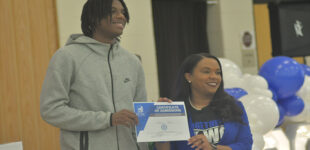Local basketball coaches share what they wished parents knew (part 5)

By KP Brabham
The past three weeks we’ve heard from head varsity boys basketball coaches representing public magnet, private, and public charter schools. One traditional public school within the Winston-Salem/Forsyth County School (WS/FCS) district that left an impression is Carver High School. Carver was once known for its large student population, basketball and football championships, academics, student fashion, and a school spirit that was unmatched. Today, alumni have distant memories without a plan to bring that Jacket pride back into the halls of Carver High.
History of Forsyth County school desegregation
A start to the changes was the additions to the county schools – the building of Walkertown High School, Atkins Academic and Technology High School, and Winston Salem Preparatory Academy (WSPA). The existence of these schools created a rezone within the district that allowed Caucasian families to separate their children from East Winston-Salem. Low-performing and behavior-subjective students who were not invited back to attend Atkins after its transition were forced to Carver and parents took a chance in trying out what WSPA had to offer.
All this pulled from Carver’s stable student population. It was a start to the socioeconomic deprivation we’re experiencing today within the WS/FCS district. Questions have been asked by teachers and alums to the WS/FCS Board and former superintendents on how to fix the concerns, the lack of resources, parent support, and poor student engagement at Carver, without an answer. Thankfully, current superintendent Tricia McManus, along with her board and the new principal of Carver, Dr. Thyais Maxwell, have acknowledged the disparities within the county and are looking to make changes.
Extracurricular activities, including the athletic departments at schools within the WS/FCS district, have to fundraise to meet the needs of students participating in the activity. Many schools have booster clubs that provide large donations and parent support that can afford to pay over $900 for a cheerleading packet. Unfortunately, for several reasons, that fluid financial support is unheard of at Carver. The direct donations and the efforts of the booster club at Carver leave unmet needs that parents cannot make up for. These concerns and challenges are what head boys basketball coach, Jonathan Stowe, navigates through year-round.
Coach Jonathan Stowe speaks out
Coach Stowe brings six years of experience – three years as head boys varsity coach and three years as an assistant boys varsity coach – at Carver High School, and several years at the youth level from the Boys and Girls Club and summer camps.
Coach Stowe shared with me his take on high school basketball. He stated, “When students come to high school basketball, they’re the least prepared, and parents, they don’t understand the commitment from the athletes and from them as parents. The biggest thing parents don’t realize from youth ball, from middle school to high school, is the amount of time and commitment that it takes just to be a part of a team.”
Coach Stowe explained, “Most of the time when we get to the halfway point of the season, kids and parents get burned out, especially around the holidays or right after. Even so, with the seniors, if they’re not receiving the interest that they thought they would from colleges, it adds to the burnout. [Basketball] is a long season in comparison to other sports because of the number of games – we play 23 games. It’s hard for our parents and student-athletes to really understand the commitment that it takes.”
Athletic ability, character and commitment
Coach Stowe added another importance as, “Making sure they’re [student-athletes] well-rounded kids. It’s not just about their skill, but also their ability to be coached and their character.
“At Carver, we like to have a 9th-grade team. They have a shorter schedule – 10 to 15 games – which is not as strenuous on them. We do have parent meetings prior to the season and lay out the season with scheduling and how things will go. I emphasize all the time, no game, we practice.”
The main thing parents and the kids must internalize, Coach Stowe explained, is, “There are no days off; we even practice sometimes on weekends. That commitment must be communicated up front so they can decide if they want to be a part or not.”
When Coach Stowe announced practice on the weekend, the feedback from the parents was that kids will need transportation to Carver. Stowe explained that his assistant coaches and volunteers who are a part of the program know that. “If they’re going to be a part of our program, then they’ll have to transport kids, especially if it’s on the weekend. We don’t mind picking kids up, meeting parents halfway. We know a lot of our parents work and have other things going on.
“The coronavirus has taught me to have a lot of grace for the kids and things that might happen. If they have something with their family, my take is family comes first because you never get those moments back. But I emphasize that the basketball team is a part of their family, at least for four months.”
Scouting and recruiting from the AAU circuit has not been a tactic for coaches at Carver. “We are a small school, and we function with the kids in our school. In my third year we haven’t tapped into the Amateur Athletic Union (AAU). In the WS/FCS district you’re not supposed to recruit kids, but we all know that it happens. I don’t recruit. I take kids in my building. We sometimes find out about a kid we can go watch. Mineral Springs Middle School is currently using our gym because theirs is being renovated. We have a connection to Mineral Springs as one of our feeder schools. We do try to check out some of their games.”
Connecting with parents
Once a team is rostered, Coach Stowe explained that it’s important for him to know who the parents are and that they meet prior to when a student-athlete begins play. He’s had a good turnout for his parent meetings, stating, “Sometimes the turnout for the teams is better than parent meetings held by the school.” That connection “allows us to create a relationship, get their information, keep them in the loop via group text, visitation, taking kids home, so that parents know they can trust us, or trust we’re doing right by their kids.”
Transitioning to high school
The connection is important too because, Stowe stated, “It is sometimes challenging with 9th graders while they transition to high school.” Stowe provided an example of a 10th grade junior varsity (JV) player who missed basketball last year because of the pandemic. Speaking with his mom and reassuring her about how high school schedules, etc. goes was essential because he was only accustomed to AAU.”
“High school student-athletes are not in a pay-to-play situation that you can sometimes find on the AAU circuit. High school coaches do not feel moved to put a player into the game based on some organizational guidelines that are common among some AAU programs. In high school, the coach decides how much a player will play. That JV mom, like many other parents, had questions about playing time and her student-athlete’s commitment.
“It’s a growing pain situation in the transition from middle school to high school. It’s a big help if the student-athlete has at least played in middle school. At Carver, however, a lot of our students haven’t played at all. Over 50% of our student-athletes have never played an organized sport. So, coaches must handle that mentality change in practice and meeting with the team to advise what’s expected. That’s a downside with wins and losses, as well not being in an organized sport. They may have played basketball, but not within an organization, which stunts the teamwork, dedication, and determination that we emphasize as coaches that have to be coached up.”
When I asked Coach Stowe about comparing his program with other programs within the county that has athletes who have played an organized sports since an early age, his response was, “When you phrase the question, it seems like a negative effect, but sometimes it’s a positive effect, from year to year, but we get surprised by some kids who step up to be leaders on and off the court. At Carver we like to say, ‘We’re like a blank canvas waiting to be painted by someone who is great.’ We give all our student-athletes the opportunity to be great, but when they [players] have history of who they are and what they’ve done, it’s hard to mold them into who’s best for the program. We do recognize, even in the girls program, that they may not be as skilled as other teams, but we teach teamwork, determination, fortitude, and our 3Rs: respect, responsibility, and relationship.”
Academics excellence stressed
Through the pandemic many students across our nation suffered academically and goals to achieve academic excellence became nonexistent. Coach Stowe mentioned that academic excellence can sound cliché, but it comes first from the administration that if the student-athlete is not in good standing, then they cannot play. Coach Stowe was proud to announce that every student-athlete he’s coached in the last five years has graduated high school.
“Our mission at Carver is for student-athletes to be enrolled in college, employed, or enlisted in the military (E3).” Proudly, Coach Stowe added that no one on his boys varsity team was on academic support, all on honor roll, and that was the first time for him since his start as a math teacher in 2015 at Carver. “We stress to parents from the beginning there’s no way your kid won’t be a good student if he plays basketball because they have to be in school every day, they have study hour, and my staff and I do check-ups with their teachers to make sure they’re on the path to graduate on time. Parents must know that expectation from the beginning of what it takes to be a student-athlete and must know it’s a privilege to be a student-athlete, not a right.”
No student-athlete can be successful without the academic side of school. Coach Stowe explained that some parents are confused about eligibility when transitioning into high school and through graduation. Basketball eligibility is based on the previous semester. “We had players in the 10th grade – especially because last year was so different – who were unable to play at all. We had transfers from outside of our district to the program who were unable to play until January. Players can risk not playing all year just because of what happened last year. I want to stress to parents that grades and attendance matter from the year before, from the semester before. As for basketball, we don’t start the year off, football starts that academic year off. I stress to parents if students don’t do well in their first semester, it affects their eligibility for basketball. Every semester counts. The spring semester affects if a student-athlete wants to play in the fall. At Carver, we only have 650 students, so a lot of our students play more than one sport. Even if they don’t, we still try to make sure athletes remain engaged in the classroom to be eligible to play the sport they want to play.”
When asked how incoming freshmen are eligible, Coach Stowe explained that based on the WS/FCS district high school guidelines, all 9th graders are eligible. The only way eligibility is not there for the student is if he or she did not pass the 8th grade, but is moved forward anyway for varying circumstances
“The 9th grade is a new start for parents and the students. We try to catch students in the 9th grade to make sure they play a sport to help them stay engaged and involved in the school. Studies at Carver show that the majority of the dropouts are in 9th grade with students who did not obtain those five credits to become a sophomore.”
End game: graduation
During the early part of the pandemic, Coach Stowe explained that at Carver, they did early alerts to parents by checking grades as early as possible. “At Carver we’re a mastery school, which means students get multiple opportunities to master their standards in each class. With me being a math teacher, I check on our student-athletes early. Our athletic director (AD) Mr. Piggott, Jr. and assistant AD, Ms. Horne, do a good job of informing us of who is in danger of being on academic support or being ineligible. It really does help that I’m in the building, have that access, and can notify our parents early. It’s much better with students being in the building versus how it was during COVID remote learning.
“At Carver I’m holding my players to an academic standard to make sure they graduate. We had a few kids to go to the next level and play, yet we hold our student-athletes to a higher academic standard and character as opposed to what some coaches focus on with AAU teams.
“Our goal is to keep everyone working toward the common goal of graduation.”














